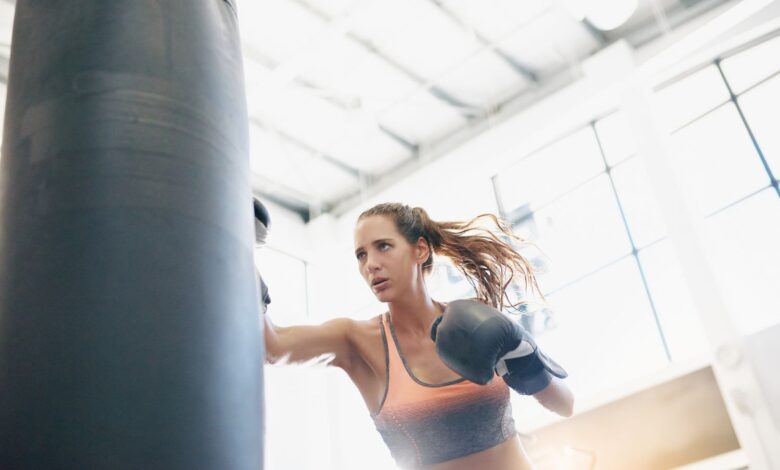A Beginner’s Guide to Kickboxing

One huge perk of hitting the gym is sweating out stress that may have built up during your day. Whether it’s office politics or an annoying leak in the ceiling, exercise has the ability to distract, relieve, and re-focus your perspective.
Sometimes changing up your usual yoga flow or running route is helpful, but other times an entirely new format of training is exactly what you need to lighten whatever stress you’re feeling. Kickboxing, while not as common as Pilates, spin, or other popular fitness styles, is a fun, exciting way to spice up your sweat session—taking your stress out on a punching bag is a healthy way to work stress out of your system. You might even like it enough to incorporate the workout into your normal routine.
History of Kickboxing
Kickboxing is a full-contact martial art that originated in Thailand, in an early form called Muay Thai. Muay Thai was developed for self-defense but became a sport when unarmed combat was no longer useful in war. Kickboxing came about as a mixture of Muay Thai and inspiration from other martial arts.
After a while, this became a full-contact sport, with timed rounds, and eventually even moved into a boxing ring. It was then the name “kickboxing” came about.
If you are interested in kickboxing, you’re not alone. Thanks to Tae Bo’s best-selling workout videos, kickboxing became popular in group fitness circles in the 1990s and early 2000s. This was eventually known as cardio kickboxing. Many other instructors then created videos and classes based on cardio kickboxing. Not only that, but there are often other variations of martial arts and boxing workouts available at group fitness centers.
Benefits of Kickboxing
Exercising can improve your energy levels, control your blood pressure, and help you sleep better. There are many benefits to exercise and group fitness—kickboxing brings its own specific benefits to the table.
Physical Benefits
Kickboxing can target many muscles, though it partially depends on what style of kickboxing you are doing. Cardio kickboxing is more cardio-intensive and focuses on your abs. Regular kickboxing is a martial art and can target muscles all over your body. Most commonly, kickboxing targets upper body strength.
Kickboxing can improve upper body strength and improve aerobic power, anaerobic fitness, flexibility, speed, and agility.
Everyday Benefits
Due to the amount of cardio involved in kickboxing, it is excellent for improving your cardiovascular health. Your cardiovascular health refers to your heart and blood vessels. Having a healthy heart can help mitigate heart disease and other heart problems.
Kickboxing can also help you work on your coordination and balance. Kickboxing requires hand-eye coordination, spatial awareness, and a fast reaction time. Constantly working to improve these areas can also help you in your everyday life.
Tommy Dibernardo, former MMA fighter and trainer at RockBox Fitness, says kickboxing incorporates multiple planes of motion essential for daily movement.
How to Start Kickboxing
Kickboxing is a full-contact sport that requires intensive full-body training. If you are interested in kickboxing, here are some ways important things to do as you get started.
Choose an Instructor and Style
Certified expert personal trainer Corey Nelson recommends starting with a no-contact cardio kickboxing group fitness class if you are a beginner. They are offered at most YMCAs, local health clubs, and boutique studios. Cardio kickboxing can be a non-intimidating way to begin kickboxing workouts, and group fitness is accessible and affordable compared to a personal trainer.
If you have some experience kickboxing or prefer a contact sport, competitive kickboxing is offered in smaller classes. If you eventually decide to become serious about kickboxing, you could also look into a personal trainer to work with you alongside competitions.
No matter what kind of instructor and class type you choose, you should talk to your instructor about your fitness level and overall health. Be sure to share any health complications or injuries that they should be aware of.
Get the Right Kickboxing Gear
According to Dibernardo, most studios will require that you have hand wraps and boxing gloves. These are to protect your hands from injury. Of course, you should get a nice big water bottle, too. These are the basic requirements, though you should always talk to your instructor to determine any requirements for the types of equipment you need to buy.
Nelson elaborated further that you will want grippy sneakers and a hair tie if your hair is long. Safety gear can include:
- Bag gloves
- Sparring gloves
- Headwear
- Mouthguard
- Shin guards
Any clothes you wear should be comfortable but not too baggy or susceptible to being caught on anything. Also, be sure to take out any jewelry—it can cause injuries or get caught on things.
Kickboxing and Mental Health
Kickboxers often perform in high-pressure environments and must be highly motivated and strong-willed. Failure is not easy for anyone, and as a kickboxer, you will not win every match. Many kickboxers have to work on their confidence to endure the competitive nature of kickboxing matches.
Kickboxing is a constant battle between brain and body to keep pushing yourself to do better, so it’s essential to have the right mindset. Continuously improve your physical fitness, don’t take losses too hard, and make sure to prioritize healing from any injuries you may face.
A Word From Verywell
Kickboxing is an exciting way to switch up your routine and get a great workout. You might like it so much that it becomes a regular part of your routine. No matter how often you find yourself in a kickboxing environment, maintaining a healthy mindset and proper safety techniques are crucial.



